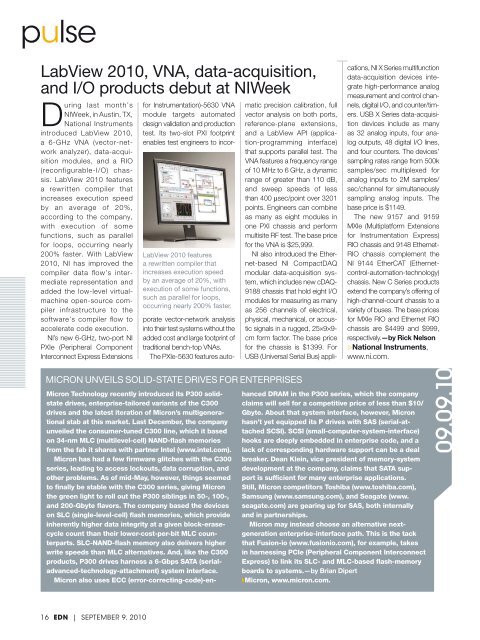VOICE OF THE ENGINEER - ElectronicsAndBooks
VOICE OF THE ENGINEER - ElectronicsAndBooks
VOICE OF THE ENGINEER - ElectronicsAndBooks
- No tags were found...
You also want an ePaper? Increase the reach of your titles
YUMPU automatically turns print PDFs into web optimized ePapers that Google loves.
pulseLabView 2010, VNA, data-acquisition,and I/O products debut at NIWeekDuring last month’sNIWeek, in Austin, TX,National Instrumentsintroduced LabView 2010,a 6-GHz VNA (vector-networkanalyzer), data-acquisitionmodules, and a RIO(reconfigurable-I/O) chassis.LabView 2010 featuresa rewritten compiler thatincreases execution speedby an average of 20%,according to the company,with execution of somefunctions, such as parallelfor loops, occurring nearly200% faster. With LabView2010, NI has improved thecompiler data fl ow’s intermediaterepresentation andadded the low-level virtualmachineopen-source compilerinfrastructure to thesoftware’s compiler fl ow toaccelerate code execution.NI’s new 6-GHz, two-port NIPXIe (Peripheral ComponentInterconnect Express ExtensionsLabView 2010 featuresa rewritten compiler thatincreases execution speedby an average of 20%, withexecution of some functions,such as parallel for loops,occurring nearly 200% faster.for Instrumentation)-5630 VNAmodule targets automateddesign validation and productiontest. Its two-slot PXI footprintenables test engineers to incorporatevector-network analysisinto their test systems without theadded cost and large footprint oftraditional bench-top VNAs.The PXIe-5630 features automaticprecision calibration, fullvector analysis on both ports,reference-plane extensions,and a LabView API (application-programminginterface)that supports parallel test. TheVNA features a frequency rangeof 10 MHz to 6 GHz, a dynamicrange of greater than 110 dB,and sweep speeds of lessthan 400 μsec/point over 3201points. Engineers can combineas many as eight modules inone PXI chassis and performmultisite RF test. The base pricefor the VNA is $25,999.NI also introduced the Ethernet-basedNI CompactDAQmodular data-acquisition system,which includes new cDAQ-9188 chassis that hold eight I/Omodules for measuring as manyas 256 channels of electrical,physical, mechanical, or acousticsignals in a rugged, 25×9×9-cm form factor. The base pricefor the chassis is $1399. ForUSB (Universal Serial Bus) applications,NI X Series multifunctiondata-acquisition devices integratehigh-performance analogmeasurement and control channels,digital I/O, and counter/timers.USB X Series data-acquisitiondevices include as manyas 32 analog inputs, four analogoutputs, 48 digital I/O lines,and four counters. The devices’sampling rates range from 500ksamples/sec multiplexed foranalog inputs to 2M samples/sec/channel for simultaneouslysampling analog inputs. Thebase price is $1149.The new 9157 and 9159MXIe (Multiplatform Extensionsfor Instrumentation Express)RIO chassis and 9148 Ethernet-RIO chassis complement theNI 9144 EtherCAT (Ethernetcontrol-automation-technology)chassis. New C Series productsextend the company’s offering ofhigh-channel-count chassis to avariety of buses. The base pricesfor MXIe RIO and Ethernet RIOchassis are $4499 and $999,respectively.—by Rick Nelson▷National Instruments,www.ni.com.MICRON UNVEILS SOLID-STATE DRIVES FOR ENTERPRISESMicron Technology recently introduced its P300 solidstatedrives, enterprise-tailored variants of the C300drives and the latest iteration of Micron’s multigenerationalstab at this market. Last December, the companyunveiled the consumer-tuned C300 line, which it basedon 34-nm MLC (multilevel-cell) NAND-flash memoriesfrom the fab it shares with partner Intel (www.intel.com).Micron has had a few firmware glitches with the C300series, leading to access lockouts, data corruption, andother problems. As of mid-May, however, things seemedto finally be stable with the C300 series, giving Micronthe green light to roll out the P300 siblings in 50-, 100-,and 200-Gbyte flavors. The company based the deviceson SLC (single-level-cell) flash memories, which provideinherently higher data integrity at a given block-erasecyclecount than their lower-cost-per-bit MLC counterparts.SLC-NAND-flash memory also delivers higherwrite speeds than MLC alternatives. And, like the C300products, P300 drives harness a 6-Gbps SATA (serialadvanced-technology-attachment)system interface.Micron also uses ECC (error-correcting-code)-enhancedDRAM in the P300 series, which the companyclaims will sell for a competitive price of less than $10/Gbyte. About that system interface, however, Micronhasn’t yet equipped its P drives with SAS (serial-attachedSCSI). SCSI (small-computer-system-interface)hooks are deeply embedded in enterprise code, and alack of corresponding hardware support can be a dealbreaker. Dean Klein, vice president of memory-systemdevelopment at the company, claims that SATA supportis sufficient for many enterprise applications.Still, Micron competitors Toshiba (www.toshiba.com),Samsung (www.samsung.com), and Seagate (www.seagate.com) are gearing up for SAS, both internallyand in partnerships.Micron may instead choose an alternative nextgenerationenterprise-interface path. This is the tackthat Fusion-io (www.fusionio.com), for example, takesin harnessing PCIe (Peripheral Component InterconnectExpress) to link its SLC- and MLC-based flash-memoryboards to systems.—by Brian Dipert▸Micron, www.micron.com.09.09.1016 EDN | SEPTEMBER 9, 2010






![[270].pdf 37407KB Sep 02 2010 09:55:57 AM - ElectronicsAndBooks](https://img.yumpu.com/50350834/1/185x260/270pdf-37407kb-sep-02-2010-095557-am-electronicsandbooks.jpg?quality=85)
![draaien, A Viruly 1935 OCR c20130324 [320]. - ElectronicsAndBooks](https://img.yumpu.com/49957773/1/190x252/draaien-a-viruly-1935-ocr-c20130324-320-electronicsandbooks.jpg?quality=85)


![20051110 c20051031 [105].pdf 35001KB Feb 18 2009 08:46:32 PM](https://img.yumpu.com/48687202/1/190x253/20051110-c20051031-105pdf-35001kb-feb-18-2009-084632-pm.jpg?quality=85)





